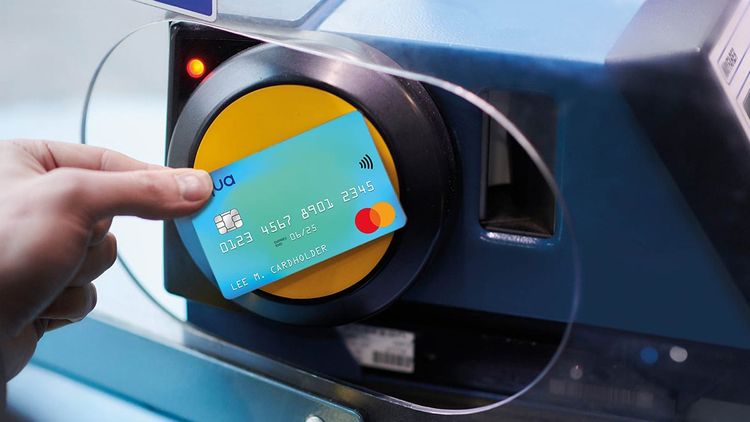In this article
Can you pay off a credit card with another credit card?
Thinking about paying one credit card with another? Find out if it’s possible, how balance transfers work, and smarter ways to manage your credit card debt.

Although it’s usually not possible to pay off a credit card with another credit card, there are other options available to you, such as a balance transfer or a cash advance.
But before you decide on a way to pay off your existing debt, it’s important to thoroughly understand your options and what works best with your financial situation.
In this guide, we’ll explain how a balance transfer works and share expert tips on ways you can manage credit card repayments to financially get back on track.
Can you pay one credit card with another directly?
You usually can’t make a direct payment from one credit card to another. Lenders prefer payments to come from a current account with actual funds, rather than another line of credit.
If you don’t have sufficient funds in your current account to pay off your credit card, there are other options available to you, such as a balance transfer, money transfer, or a cash advance.
Where money transfers or cash advances can offer a quick solution (that often come with high interest rates), taking advantage of a balance transfer promotion could be a smarter move to manage your finances and protect your credit score.
What’s right for you will depend on your financial circumstances, such as how much debt you have and when it needs to be paid off. But having a clear view on your options is the first step to making the right move
What is a balance transfer and how does it work?
A balance transfer gives you the financial flexibility to move existing debt from one or multiple credit cards to another with a lower rate of interest.
As well as helping to simplify repayments by consolidating multiple debts to a single credit card, it can also help you save money on interest by taking advantage of 0% APR offers that run for a limited period.
For example, transferring a balance of £1,000 from an existing credit card account with 15% APR to a new account with a 0% introductory rate could save you up to £150 in interest. But to fully benefit from a balance transfer, you should clear your balance before the promotional period ends. Otherwise, you could be faced with higher rates of interest.
Depending on the lender, you can typically transfer up to 90% of your available credit limit (which is usually inclusive of the balance transfer fee). It’s also likely there’s a minimum transfer amount which, for an Aqua balance transfer credit card, is £100.
To start the process, you should compare different offers to fully understand the pros and cons of a balance transfer. As well as checking fees, you should compare what interest rates look like once the promotional period has ended.
Once you’ve chosen a lender and been accepted for a new balance transfer credit card, you can usually request a balance transfer either by phone or through an online portal. You’ll need to state how much you wish to transfer, as well as provide the card details of your account with the existing debt.
Depending on the lender, a balance transfer request usually takes between three hours to three days to approve. During this time, you should continue to make monthly repayments on your existing credit card balance to avoid any late fees or other charges.
How to manage your minimum payments effectively
Staying on top of credit card payments can be challenging, especially if you have multiple accounts with different deadline dates.
To keep your finances in shape, you could consider setting up a bank transfer or direct debit from your current account. Depending on available funds, you can set automatic payments to pay off the minimum monthly amount or the full balance – whatever works best for you.
If you prefer to make manual payments with varying amounts each month, you could set up payment reminders, which is usually an option available from within your online account or by calling your lender.
Other options to help you manage repayments can also include a debt consolidation loan, which helps to simplify debt into a single monthly payment, but often at the cost of a high interest rate.
With whichever option you use to manage debt, it’s important to pay at least the minimum amount on time every month. Or, if you have the available funds in your current account, it’s best to clear your entire balance to avoid paying interest.
When is it a bad idea to use one credit card to pay another?
Although paying off one credit card with another might seem like a quick-fix solution, it often comes with drawbacks that could cause further debt and potentially damage your credit health.
For example, using a cash advance to pay off your credit card debt might mean you pay more in the long run due to higher interest rates immediately applied to your balance.
By transferring your balance from one account to another, you could also run the risk of increasing your credit utilisation ratio which is a common factor that influences credit scores.
It also means you’re maintaining the same amount of persistent debt, which may offer some financial breathing space, but doesn’t solve the issue of being overly reliant on credit.
For that reason, the smarter way to manage your finances is to gradually pay down balances using tools like direct debits, budgeting apps, and payment reminders to help you stay on track.
How to manage credit card repayments responsibly
Even though it’s not possible to directly pay off one credit card with another, there are financial habits you can put in place to manage credit card payments responsibly.
Set up a direct debit
By setting up a direct debit to pay off your credit card balance, you’re more likely to avoid late fees and interest rates. You’ll also be in a stronger position to protect your credit score.
Pay more than the minimum amount
Carrying a persistent credit card balance from one month to the next will often mean you pay more interest. Where possible, go beyond the minimum payment to save more in the long run.
Use payment reminders or budgeting tools
If you struggle to make payments on time or tend to spend beyond your means, explore a range of free tips, tools, and advice to help you simplify account management.
Review your statements regularly
By regularly reviewing credit card statements, you’re in a better position to take stock of your finances, review spending habits, and understand how interest and fees affect repayments.
Putting sensible repayment habits in place can go a long way to build your credit score and make it easier to secure better rates in the future. With our Aqua app, you can access a range of online account management tools that make it easier to track payments and stay in control.
Although you can’t directly pay off one credit card using another, other options to manage and consolidate your debt are available, such as a balance transfer credit card.
If you feel a balance transfer credit card is right for you, take our free eligibility check– with no onward impact on your credit score.
Representative 39.9% APR (variable) for Aqua Classic
Failure to make payments on time or to stay within your credit limit means that you will pay additional charges and may make obtaining credit in the future more expensive and difficult.
Contributors

Hayley Bevan
Hayley is an editor at Aqua.

Victoria Smith
Victoria is an editor at Aqua.
You might also like
Slide 1 of 3
How does credit card interest work?
Learn about how credit card interest works, including how it's calculated, when it's charged, and strategies to avo...
Hayley Bevan

How many credit cards should you have?
Learn more about how many credit cards you should own. Discover the pros and cons of multiple credit cards and find...
Hayley Bevan

How credit card payments work
Learn how credit card payments work, how and why credit card charges are applied and how to manage payments.
Victoria Smith
The smart way to build better credit
Aqua is the credit card that gives you the power to improve your credit score
